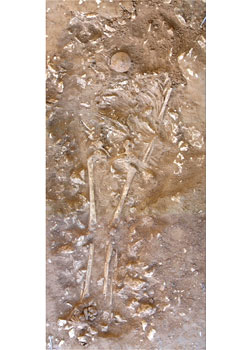February 10, 2004
Xena-like remains found
From the article at Discovery News:
 The remains of a six-foot tall woman, buried with a shield and knife, were recently discovered in an Anglo-Saxon cemetery in Lincolnshire, England.
The remains of a six-foot tall woman, buried with a shield and knife, were recently discovered in an Anglo-Saxon cemetery in Lincolnshire, England.
The body and artifacts, which date to A.D. 500-600, suggest that more women than previously believed may have fought alongside men during the turbulent years following England's Roman period.
Archaeologists made the discovery while working on a program for Britain's Channel 4 "Time Team."
en Dempsey, assistant producer of the show, told Discovery News that the shield had been placed on top of the woman before burial. The knife rested alongside her unusually tall body. Even most men at the time measured several inches shorter.
Another unusual aspect of the burial was that the feminine jewelry and clothing accessories normally found in women's graves from this period were not present. Instead, her feet were bound with rope, and the only adornment was an amber necklace draped around her neck.
While some locals are calling the woman a "warrior queen," Dempsey doubts she had any royal connections, like the fictional character Xena, or the real life war hero Boadicea, Queen of the Iceni, who led a successful rebellion against the Romans in A.D. 60.
"Nothing to suggest a high social rank was found at her gravesite," Dempsey said. "However, she may very well have fought in battle, since many people at the time served as warriors at some stage."
When the last Roman legion left Britain in A.D. 409-410, tribal warfare increased in England. The unstable political conditions, combined with invading forces from all directions, led to many individuals arming themselves for protection.
The Anglo-Saxon woman's shield, while not ornate, is of interest to British researchers.
Lincolnshire County Council archaeologist Adam Daubney told the Lincolnshire Echo newspaper, "The shield would have been originally made from wood but the boss — which held the handle in place — was made of iron and this has survived."
Daubney added, "One of the interesting things about this [site] is that a total of four shields have been found."
In addition to the shields, remains of two other individuals — a man and another woman — were unearthed. None of the individuals appears to have been related or otherwise connected to one another.
According to Dempsey, the second woman was of average height and wore the wrist clasps, girdle hangers, and little pieces of bronze jewelry more commonly found in female graves of the time.
The man was discovered in a fetal position with one hand wrapped around a pot, a form of burial that has never before been documented among Anglo-Saxons for this period. Archaeologists speculate that the pot could have contained wine or grain, and was meant to ease the individual's passage into the afterlife.
Next month, Wessex Archaeology will further analyze all of the remains and items found at the Lincolnshire site. The artifacts then will be housed in the City and County Museum of Lincoln.
Posted by Tom at February 10, 2004 08:19 PM